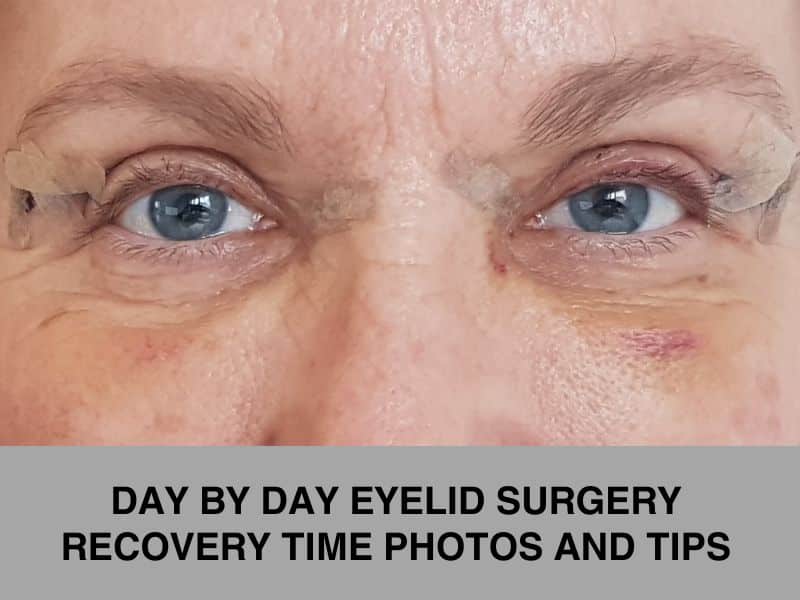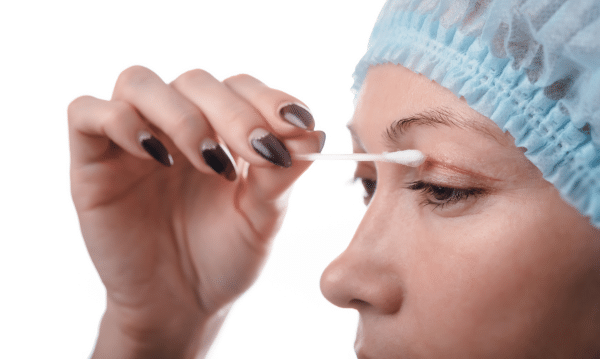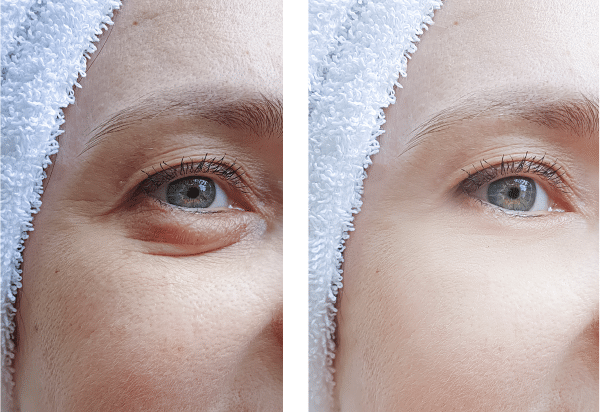
If you’ve recently undergone blepharoplasty in Dallas or are considering it, understanding what to expect during your recovery will help make the experience easier and less stressful. And while looking at photos is certainly beneficial, simply knowing what each day will bring can help settle your mind as well.
This plastic surgery procedure article will take you through a day-by-day and week-by-week journey, highlighting the recovery process, results, improvements, and necessary restrictions. We’ll also provide some unique eyelid surgery recovery tips to help optimize your healing process and ensure the best possible outcome.
Day by Day Lower Eyelid Surgery Recovery Time Photos and Tips
Day One (Immediately After Surgery)
On the day you return home after your procedure, swelling, bruising, and some discomfort are common. It’s essential to have someone accompany you on your drive home, and having some assistance at home can be beneficial as well.
Some daily activities may be more difficult at first. This is because your vision may be blurred, and you might experience sensitivity to light. If you’ve had excess skin removed, these symptoms may be slightly worse at the outset. But you can reduce swelling in some cases with a cold compress (always check with your surgeon).
Day Two
As you wake up on the second day, the swelling and bruising may have intensified, but again, this is normal. Continue following your surgeon’s recovery instructions by using the necessary eye drops and taking your medications as directed. Ensure you keep your head elevated to minimize swelling, and avoid strenuous activities.
Day Three
By the third day, some patients notice a reduction in swelling and bruising. However, do not be alarmed if it is still present. Follow your surgeon’s instructions on wound care and medications carefully.
Week One
During the first week, you may still experience some residual swelling, but it should gradually improve. Bruising will also be present during this week.
You might be able to return to light daily activities, but avoid anything that could strain your eyes or cause dryness. Attend your follow-up appointment with your surgeon to monitor progress. Usually, after about a week, sutures can be removed, and you can return to work.
Weeks 2-3
By this stage, most patients are back at work and have observed significant improvements in swelling and bruising. You may feel more comfortable resuming additional daily activities and light exercise, which can help increase blood flow. Still, as with any cosmetic surgery recovery, avoid activities that could risk injury to your healing eyelids.
Weeks 4-5
Around the fourth and fifth weeks, you will likely notice more substantial improvements in the appearance of your upper eyelids if you’ve had upper blepharoplasty and in your lower eyelid skin if you’ve had lower eyelid surgery.
The majority of the swelling should have subsided, and your final results will start to become apparent. Most patients can go back to a normal exercise regimen around four weeks after surgery.
Week 6 and Beyond
At this point, your lower or upper eyelid surgery recovery should be mostly complete. However, remember that individual healing rates vary. It’s essential to continue following your surgeon’s advice, wear sunscreen to protect your delicate eye skin, and avoid excess sun exposure.

How to Optimize Your Blepharoplasty Recovery and Maximize Your Results
Here are some tips and self-care instructions recommended by cosmetic surgeons to promote improved healing after lower or upper eyelid surgery.
1. Follow your surgeon’s instructions.
Listen carefully to your surgeon’s post-operative instructions after upper or lower eyelid surgery. These guidelines are tailored to your specific situation and can significantly impact your recovery and final results.
2. Keep your head elevated.
Elevating your head while resting can aid in reducing swelling and promoting a more comfortable recovery.
3. Avoid intensive exercise and strenuous activities.
Avoid any activities that could strain your eyes, including heavy lifting, vigorous exercise, and bending over.
4. Protect your eyes from the sun.
Wear sunglasses and use sunscreen to protect your sensitive eyelids from harmful UV rays.
5. Stay hydrated and eat nutritious foods.
Proper hydration and a balanced diet can support your body’s healing process and promote optimal recovery.
6. Take day by day eyelid surgery recovery time photos to track progress.
By taking regular photos of yourself, you can see what your eyelid surgery before and after looks like and the changes that have occurred. You’ll naturally want upper day by day eyelid surgery recovery time photos if you’ve undergone upper blepharoplasty and photos of your lower lids if you’ve undergone lower blepharoplasty. As you continue to improve, go back over your photos so that you can see your improvements and give yourself motivation and encouragement.
7. Get adequate rest.
Allow your body ample time to heal by getting a good night’s sleep every night. Whenever you feel tired, try to let yourself relax and rest.
8. Manage discomfort with medication.
If needed, take prescribed pain medication as directed to manage post-surgery discomfort.
9. Don’t wear contact lenses or eye makeup.
If you wear contact lenses as a rule, ensure you do not wear your lenses for the first few weeks following surgery (ask your surgeon for precise times). The same goes for eye makeup.

Why Take Day-by-Day Eyelid Surgery Recovery Time Photos?
Taking daily photos throughout your eyelid surgery recovery can offer many benefits. Here’s why it’s worth doing:
Track Your Healing Journey
Photos are an excellent way to visually track your progress, from swelling and bruising to the final results. It can be hard to notice gradual improvements day-to-day, but having a photo record lets you see how far you’ve come.
Spot Any Potential Issues
Regular photos allow you to catch any unusual signs, like increased swelling or possible infection. Identifying issues early helps ensure you can take action quickly and stay on track with your recovery.
Understand Your Personal Recovery Timeline
Healing can vary from person to person, and taking photos gives you a clear picture of your own healing process. It helps you understand what’s normal for your recovery and what might need a closer look.
Celebrate Your Progress
It’s easy to forget how much you’ve improved. Photos give you a visual reminder of your progress and can serve as motivation, making it easier to stay positive as you heal.
Create a Visual History
Having a detailed photo record of your recovery can be useful if you need to consult your surgeon about any concerns. It provides valuable context and helps them better understand your healing process.
Share Your Experience
If you’re open to it, sharing your recovery journey can be a great way to support others. Your photos can help those considering eyelid surgery better understand what to expect along the way.
Common Concerns After Eyelid Surgery
After eyelid surgery, it’s normal to experience some swelling, bruising, and mild discomfort as you heal. Understanding what to expect can help ease any concerns. Here are the most common issues and how to manage them:
- Swelling and Bruising: Swelling and bruising are some of the most common side effects after eyelid surgery. These will be more noticeable during the first few days, but don’t stress – it’s a normal part of the healing process. The good news is that both swelling and bruising will gradually improve within a couple of weeks.
- Dryness or Irritation: Your eyes may feel a bit dry or irritated, which can happen after eyelid surgery. This is usually temporary and can be managed with the lubricating eye drops your surgeon prescribes. Just follow your doctor’s instructions, and the discomfort should subside over time.
- Blurry Vision: A bit of blurry vision is common in the first few days after surgery, especially with swelling or ointments applied to the eyes. While it can be a little unsettling, it’s typically short-lived. If you’re still experiencing blurry vision after a few days, be sure to reach out to your surgeon for advice.
- Tightness or Mild Discomfort: You may feel some tightness or mild discomfort around your eyelid area as it heals. This sensation is normal and should improve over time. If needed, your surgeon will prescribe pain relief to keep you comfortable during recovery.
- Temporary Asymmetry: It’s not uncommon for one eye to heal a bit quicker than the other, which may cause some temporary asymmetry. Don’t worry – this is completely normal, and the final results will become more balanced as the swelling goes down and the healing process progresses.
By staying informed and following your surgeon’s aftercare recommendations, you’ll be well on your way to a smooth and speedy recovery. And if anything feels off, don’t hesitate to reach out to your surgeon for advice.
What Can Affect Your Blepharoplasty Recovery?
Several factors can impact your recovery after blepharoplasty. Here’s what you should keep in mind:
- Your Health and Age: Generally, younger and healthier individuals tend to heal more quickly. If you have underlying health conditions, like diabetes, they could slow down your recovery.
- Following Aftercare Instructions: Adhering to your surgeon’s post-op guidelines is key to a smooth recovery. This includes avoiding strenuous activities and keeping your head elevated as advised.
- Smoking: Smoking can hinder healing by reducing blood flow, increasing the risk of complications, and possibly prolonging recovery. It’s best to avoid smoking before and after surgery.
- Sun Exposure: Direct sun exposure to your eyes can lead to pigmentation changes or scarring. Make sure to wear sunglasses and use sunscreen to protect your delicate skin.
- Medications and Supplements: Certain medications or supplements, like blood thinners, can interfere with healing or increase the risk of bleeding. Be sure to let your surgeon know what you’re taking.
- Infection or Complications: While rare, infections or other complications could affect recovery. Watch for signs like unusual swelling, redness, or pain, and contact your surgeon if you have concerns.
Blepharoplasty Recovery Time FAQS
How long does it take to look normal after eyelid surgery?
After surgery, your eyelid may be swollen and bruised for 1 to 3 weeks. The appearance of your eye will continue to improve over 1 to 3 months. Most people feel ready to return to public activities and work within 10 to 14 days.
What does eyelid surgery look like after 2 weeks?
Two weeks after upper eyelid surgery, swelling and bruising around your eyes should have significantly decreased. By this time, you should start seeing the results of your blepharoplasty, with your eyes looking more open and refreshed.
Why can’t you watch TV after eyelid surgery?
To help with recovery, it’s wise to limit reading, TV watching, and computer use for the first few days after surgery. Your eyes may feel dry and tired, making screen time or reading unappealing.
What does eyelid surgery look like after 2 weeks?
Two weeks post-upper eyelid surgery, you should notice a significant reduction in swelling and bruising around your eyes. At this stage, the results of your blepharoplasty will begin to show, with your eyes appearing more open and rejuvenated.
How much does eyelid surgery cost?
The average price for cosmetic eyelid surgery is approximately $3,359 for an upper blepharoplasty and $3,876 for a lower blepharoplasty, according to recent statistics from the American Society of Plastic Surgeons. However, this cost only reflects the procedure itself and does not include additional expenses like anesthesia, operating room fees, or other associated costs. To get a complete estimate, it’s recommended to speak with your plastic surgeon’s office directly.
Contact Us to Schedule a Consultation Appointment
 Now that you know what to expect during your eyelid surgery recovery, remember that everyone’s recovery journey will be unique, and it’s essential to follow your surgeon’s instructions closely.
Now that you know what to expect during your eyelid surgery recovery, remember that everyone’s recovery journey will be unique, and it’s essential to follow your surgeon’s instructions closely.
If you have any questions or concerns or would like to learn more about eyelid surgery, we encourage you to contact us and schedule a consultation appointment. At your appointment, you and board certified plastic surgeon Dr. Mohan can discuss more about eyelid surgery cost, recovery, surgery candidacy, and more.
Our experienced team is here to help you feel better about yourself and achieve your desired results. Don’t hesitate to take the first step toward a more vibrant and confident you. Call us today!